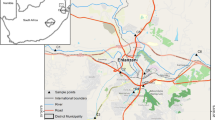Abstract
Previous work has shown that the composition and diversity of nematode populations in Liverpool Bay (UK) are correlated with sediment granulometry, and possible reasons for this relationship are now discussed. Sediment granulometry and nematode size appear not to be directly related, but the range of nematode lengths is greater in the more heterogeneous sediments. Median particle diameter, sorting efficiency and silt/clay content are all considered to affect sediment uniformity, and an index including all three factors correlated significantly with both size diversity and species diversity. Study of the distribution of the various feeding types revealed that the relative and absolute abundances of epistratum feeders and non-selective deposit feeders correlated significantly with the sediment silt/clay content. It is concluded that sediment granulometry influences nematode distribution both directly in determining the size range of the populations (and hence, to some extent, the species diversity) and indirectly in determining, to a great extent, the type of food available. In addition, it was noted that nematodes with very ornate cuticular ornamentation tended to be associated with coarser, silt-free sediments, and it is suggested that this may be correlated both with their mode of locomotion and with the need for mechanical protection in unstable substrata.
Similar content being viewed by others
Literature Cited
Crisp, D.J. and R. Williams: Direct measurement of pore-size distribution on artificial and natural deposits and prediction of pore space accessible to interstitial organisms. Mar. Biol. 10, 214–226 (1971)
Fisher, R.A., A.S. Corbet and C.B. Williams: The relation between the number of species and the number of individuals in a random sample from an animal population. J. Anim. Ecol. 12, 42–58 (1943)
Gross, M.G.: Marine waste deposits near New York. Mar. Pollut. Bull. 3 (4), 61–63 (1972)
Heip, C. and W. Decraemer: The diversity of nematode communities in the southern North Sea. J. mar. biol. Ass. U.K. 54, 251–255 (1974)
Krumbein, W.C.: Application of logarithmic moments to size frequency distributions of sediments. J. sedim. Petrol. 6, 35–47 (1936)
Morgans, J.F.C.: Notes on the analysis of shallow-water soft substrata. J. Anim. Ecol. 25, 367–387 (1956)
Perkins, E.J.: The food relationships of the microbenthos, with special reference to that found at Whitstable, Kent. Ann. Mag. nat. Hist. 13, 64–77 (1958)
Rees, E.I.S., A.J.M. Walker and A.R. Ward: Benthic fauna in relation to sludge disposal. In: Out of sight out of mind; report of a working party on sludge disposal in Liverpool Bay, Vol. 2. Appendix 14. pp 297–343. London: Her Majesty's Stationary Office 1972
Remane, A.: Verteilung und Organisation der Benthonischen Mikrofauna der Kieler Bucht. Wiss. Meeresunters. (Abt. Kiel) 21, 161–221 (1933)
Stauffer, H.: Die Lokomotion der Nematoden. Zool. Jb. (Abt. Syst. Ökol. Tiere) 49, 1–118 (1924)
Swedmark, B.: The interstitial fauna of marine sand. Biol. Rev. 39, 1–42 (1964)
Ward, A.R.: Studies on the sublittoral freeliving marine nematodes of Liverpool Bay. I. The structure and distribution of the nematode populations. Mar. Biol. 22, 53–66 (1973)
Warwick, R.M. and J.B. Buchanan: The meiofauna off the coast of Northumberland. I. The structure of the nematode population. J. mar. biol. Ass. U.K. 50, 129–146 (1970)
Wieser, W.: Free-living marine nematodes. IV. General Part. Chile Reports 34. Acta Univ. lund (N.F. Avd. 2) 55 (5), 1–111 (1959a)
—: Free-living nematodes and other small invertebrates of Puget Sound beaches. Univ. Wash. Publs Biol. 19, 1–179 (1959b)
—: Benthic studies in Buzzards Bay II. The meiofauna. Limnol. Oceanogr. 5, 121–137 (1960)
Winter, A. and M.J. Barrett: Bed sediments: chemical examination. In: Out of sight out of mind; report of a working party on sludge disposal in Liverpool Bay, Vol. 2. Appendix 13. pp 287–295. London: Her Majesty's Stationary Office 1972
Author information
Authors and Affiliations
Additional information
Communicated by J.H.S. Blaxter, Oban
Rights and permissions
About this article
Cite this article
Ward, A.R. Studies on the sublittoral free-living nematodes of Liverpool Bay. II. Influence of sediment composition on the distribution of marine nematodes. Marine Biology 30, 217–225 (1975). https://doi.org/10.1007/BF00390744
Accepted:
Issue Date:
DOI: https://doi.org/10.1007/BF00390744




